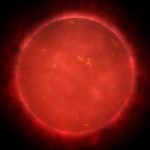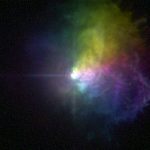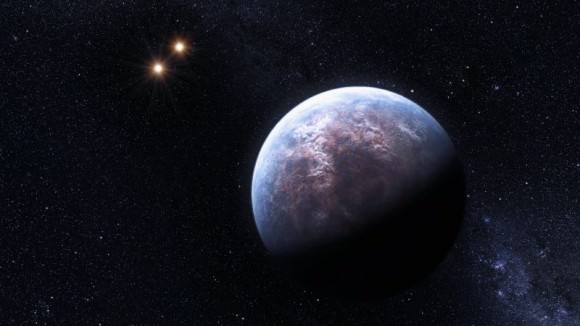Impact in Latvia Creates 20-Meter Crater

A possible meteorite fall near in northern Latvia on Sunday left a crater approximately 20 meters (66 feet) in diameter and 10 meters (33 feet) deep. UPDATE: Many reports now say the impact was a fake; The Bad Astronomer says "shovel" marks were found around the perimeter of the crater; additionally, a burning impactor is highly unlikely (see video below). And here's an article from the Associated press. , and another from Yahoo news, where a phone company in Latvia admits the "crater" was a publicity stunt.
(...)
Read the rest of Impact in Latvia Creates 20-Meter Crater (167 words)
NASA Science News for October 27, 2009
It might not be obvious to the naked eye, but the sun is a variable star. A sensor slated for launch onboard NASA's Solar Dynamics Observatory will probe the sun's "sneaky variability" with better time and spectral resolution than ever before.
FULL STORY at
http://science.nasa.gov/headlines/y2009/27oct_eve.htm?list1035898
Podcast: Dwarf Stars

We think we live near an average star, but that's not the case at all. Compared to most stars in the Universe, the Sun is a giant! Let's look at the small end of the stellar spectrum, to stars with a fraction of the size and mass of our own Sun. There are many ways that a star can get small, and they lead dramatically different lives and deaths.
Click here to download the episode.
Or subscribe to: astronomycast.com/podcast.xml with your podcatching software.
Podcast: Famous Stars

This week we're going to talk about famous stars. But not those boring human ones you read about in People magazine. No, we're talking about those hot balls of plasma across the distant Universe. The close ones, the bright ones, the massive ones, the giant ones. Let's get to know some famous stars.
Click here to download the episode.
Or subscribe to: astronomycast.com/podcast.xml with your podcatching software.
Top Questions That Keep Physicists Awake at Night

We all have things that keep us up at night, as we try to solve the problems in our lives. But just think of the poor physicists: They are trying to solve the problems of the Universe! At a recent physics conference at the Perimeter Institute for Theoretical Physics in Waterloo, Canada, a panel of scientists were asked what questions in physics kept them awake at night. Here are their answers:
(...)
Read the rest of Top Questions That Keep Physicists Awake at Night (136 words)
NASA Science News for October 23, 2009
NASA is planning a mission to study the Moon's fragile atmosphere--before it's too late.
FULL STORY at
http://science.nasa.gov/headlines/y2009/23oct_ladee.htm?list1035898
Missions to Mars Poster

If you enjoyed the zoomable poster of 50 year of space exploration, you'll probably also like this new poster of Mars missions. It's basically a bar graph, with missions to Mars as listed chronologically, and the mission result is coded by how close the corresponding bar reaches to Mars. The poster also lists a few of the upcoming missions as well. Cool!
Committee Urges Multi-Destination Plan for NASA Human Space Flig

The Augustine Commission released their final report today, and while they didn't offer specific recommendations for NASA's human space flight program, they laid out five possible options, highlighting a flexible plan that allows for several destinations out of low Earth orbit. The report also encouraged commercial space ventures to handle trips to the International Space Station. "The different options speak for themselves," said head of the commission, Norman Augustine at a press briefing today following the release of the report. "We believe Mars is clear goal of the human spaceflight program, but for safety reason we ruled out going directly there. We've offered programs that are alternatives for building a heavy lift launch capability, as we believe that to be extremely important for the human space program, and we believe this is the time to create a commercial market to transport humans to Earth orbit."
But the strongest point the committee made is that NASA needs additional funds of $3 billion a year in order to accomplish much of anything.
(...)
Read the rest of Committee Urges Multi-Destination Plan for NASA Human Space Flight (1,058 words)
The Orionid Meteor Shower – What Did You See?
If you had the opportunity this morning to witness the offspring of Comet Halley, then I'm curious as to what you might have noticed about this reliable annual meteor shower. (...)
Read the rest of The Orionid Meteor Shower – What Did You See? (303 words)
This Week's Where In The Universe Challenge

It’s time once again for another Where In The Universe Challenge. Test your visual knowledge of the cosmos by naming where in the Universe this image was taken and give yourself extra points if you can name the spacecraft responsible for this picture. Post your guesses in the comments section, and check back later at this same post to find the answer. To make this challenge fun for everyone, please don’t include links or extensive explanations with your answer. Good luck!
(...)
Read the rest of This Week's Where In The Universe Challenge (0 words)
Have a Galileo Moment

Starting tomorrow (Oct. 22) professional and amateur astronomers around the world will be out in force to encourage as many people as possible to look through a telescope. The International Year of Astronomy 2009 Cornerstone project, Galilean Nights, will be a global experience, with more than 1000 public observing events in over 70 countries. If you participated in 100 Hours of Astronomy that took place in April 2009, this event is similar, but this time astronomers will be focusing on the objects that Galileo observed, especially with the Moon and Jupiter well-positioned in the evening sky.
(...)
Read the rest of Have a Galileo Moment (136 words)
LRO, Chandrayaan-1 Scientist Arrested for Espionage

Times are tough, but you have to wonder what this guy was thinking. Stewart David Nozette, 52, who was involved in the recent discovery of water on the Moon by the Chandrayaan-1 spacecraft has been arrested for espionage for allegedly trying to sell details of US missile detection satellites in exchange for cash. Nozette was attempting to sell classified information to a person who he believed was an Israeli intelligence officer. Nozette is a fairly prominent scientist who helped conceive the 1994 Clementine mission to the Moon, and currently is a co-investigator on Chandrayaan-1, the Indian Moon mission, and on an instrument aboard the Lunar Reconnaissance Orbiter.
(...)
Read the rest of LRO, Chandrayaan-1 Scientist Arrested for Espionage (277 words)
Could a Black Hole Fit in Your Computer or In Your Pocket?

Some of the most frequently asked questions we get here at Universe Today and Astronomy Cast deal with black holes. Everyone wants to know what conditions would be like at the event horizon, or even inside a black hole. Answering those questions is difficult because so much about black holes is unknown. Black holes can't be observed directly because their immense gravity won't let light escape. But in just the past week, three different research teams have released their findings in their attempts to create black holes – or at least conditions analogous to them to advance our understanding.
(...)
Read the rest of Could a Black Hole Fit in Your Computer or In Your Pocket? (769 words)
HARPS Discovers 32 New Exoplanets
Astronomers have found 32 new planets outside our solar system with the High Accuracy Radial Velocity Planet Searcher, better known as HARPS, the spectrograph for the European Southern Observatory's (ESO) 3.6-metre telescope. The number of known exoplanets is now at 406, and HARPS itself has discovered more than 75 exoplanets in 30 different planetary systems. Included in this most recent batch are several low-mass planets – so-called "Super Earths" about the size of Neptune. The image above is an artist's impression of a planet discovered that is 6 times the mass of Earth, which circles the low-mass host star, Gliese 667 C, at a distance equal to only 1/20th of the Earth-Sun distance. Two other planets were discovered previously around this star.
"HARPS is a unique, extremely high precision instrument that is ideal for discovering alien worlds," said ESO astronomer Stéphane Udry. “We have now completed our initial five-year program, which has succeeded well beyond our expectations.”
(...)
Read the rest of HARPS Discovers 32 New Exoplanets (259 words)
Giant Impact Near India — Not Mexico — May Have Killed Dinosaurs
A huge, mysterious basin off the coast of India could be the largest, multi-ringed impact crater ever found on Earth. And if a new study is right, this impact may supercede the one that created the Chicxulub crater off Mexico's Yucatán Peninsula as what may have been responsible for killing the dinosaurs 65 million years ago. Sankar Chatterjee of Texas Tech University and a team of researchers have been studying a 500-kilometer-wide (300-mile-wide) depression on the Indian Ocean seafloor which was likely created by a bolide perhaps 40 kilometers (25 miles) in diameter. Such an event would have triggered worldwide climate changes, including intensified volcanism, that led to mass extinction.
(...)
Read the rest of Giant Impact Near India — Not Mexico — May Have Killed Dinosaurs (507 words)


